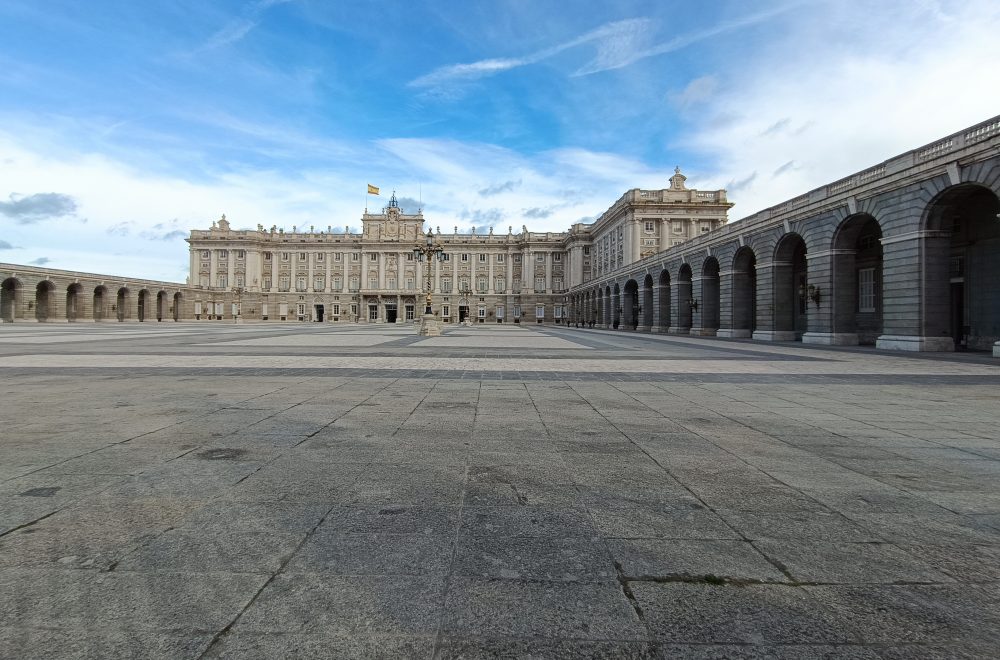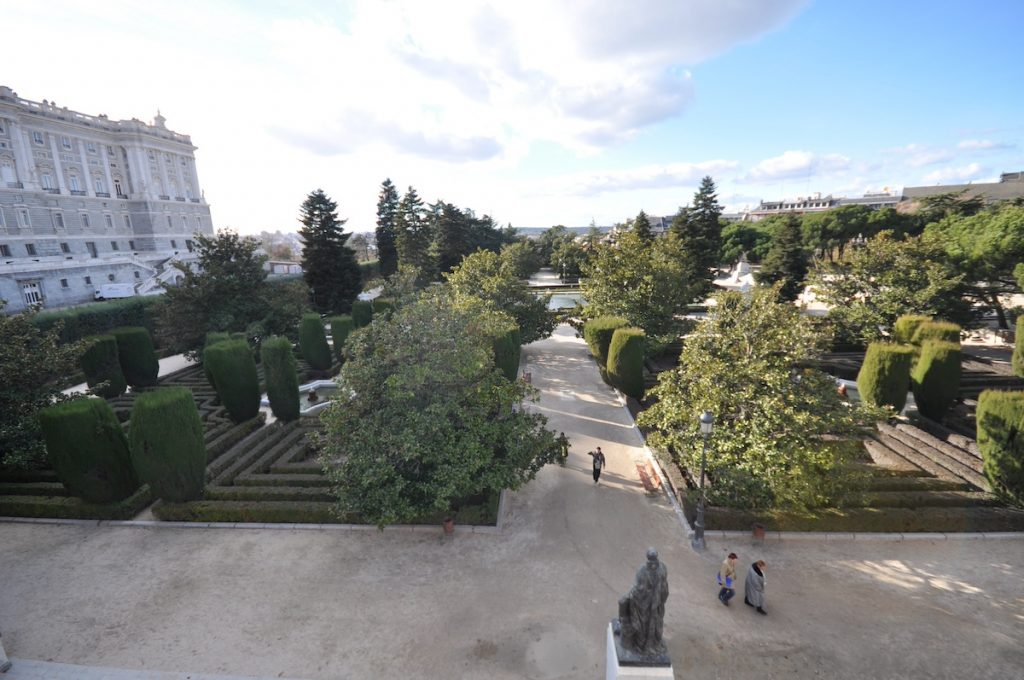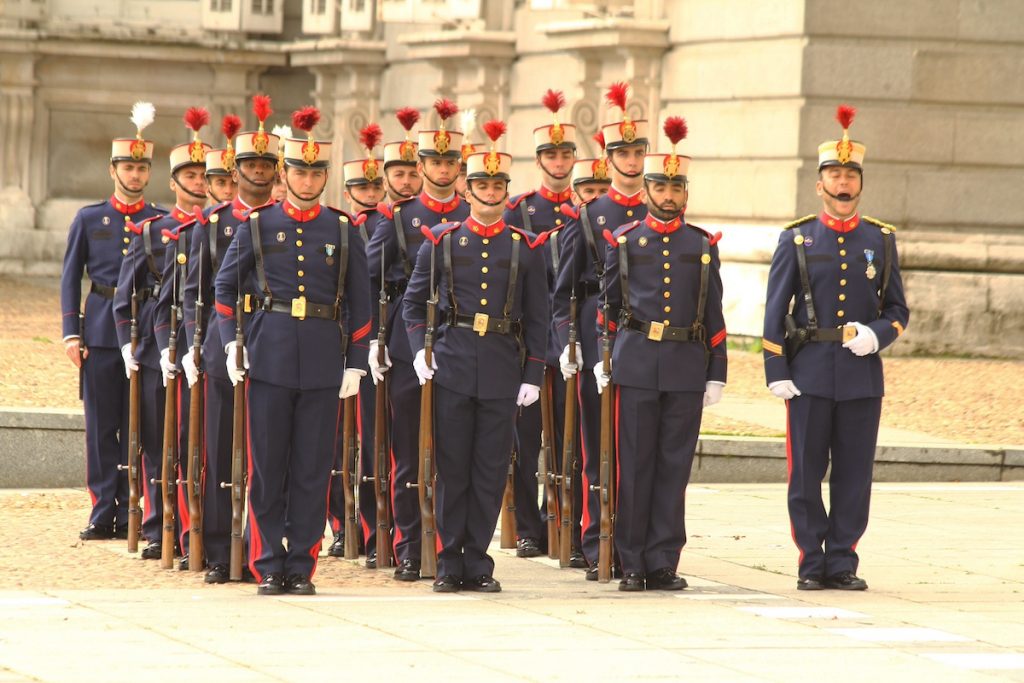
If visiting the largest royal palace in Western Europe is on your travel bucket list, don’t miss the Palacio Real Madrid. It’s been the official residence of the Spanish monarchy since the reign of Charles I (also known as Emperor Charles V) in the 16th century, but the site of the landmark we can visit today has a unique history that goes back even further.
Fun fact: While the Palacio Real Madrid is still the official residence of the Spanish monarchy, the royal family no longer uses it as their primary home. The palace is mostly used for official state ceremonies.
To say that the Royal Palace is beautiful is an understatement. Surrounded by the lush Sabatini Gardens and constructed in a Baroque style, it’s what’s inside the palace that will really wow you.
With more than 3,000 rooms extravagantly decorated and impressive collections of everything from famous paintings to Stradivarius violins, nothing compares to visiting the Royal Palace in Madrid.
Before you go, let’s get to know more about the palace, inside and out.
A brief history of the Royal Palace in Madrid

Like I said, the Royal Palace has a long history, and it all started in the 9th century when the Moors occupied “Magerit” (Madrid in Arabic) and Emir Mohamed I chose the site of the palace for the city’s fortress. The fortress was meant to protect Toledo, the ancient Spanish capital, from the advancing Christians.
The kings of Castille started to use the site in the 14th century and built the Antiguo Alcázar (old fortress), but it was Charles I who made it the official royal residence in the 16th century.
A fire that burned for four days destroyed the old fortress in 1734. It was Christmas Eve, and there was a delayed response because people confused the warning bells for church bells. Many works of art were sadly lost in the fire, and we only have paintings like Velázquez’s “Las Meninas — which now hangs in the Prado Museum — because they were tossed out of windows as the palace burned.
The Royal Palace we can visit today was constructed in the 18th century by the order of Philip V, who never got to live there since it wasn’t completed until 26 years later in 1764. Charles III was the first monarch to live in the palace.
What’s interesting about the Royal Palace’s design is that its architects were inspired by Gianlorenzo Bernini’s sketches for the Louvre in Paris. When you go, observe how it’s a square shape and looks out on a large courtyard. The palace’s 3,418 rooms have also changed over the years, as each monarch has brought their own flair for decoration.
Know before you go to the Royal Palace
Here’s some practical information you’ll need to plan your visit to Madrid’s Royal Palace.
Best time to visit
There isn’t a bad time to visit the Royal Palace, but there are fewer crowds when you go in the shoulder and off-peak seasons from October-March.
Length of your visit
Two hours is enough time to explore all the best rooms and the beautiful Sabatini Gardens.
Ticket options
Standard admission starts at €14. The Royal Palace also has options for free admission and combined tours with the Gallery of Royal Collections and Royal Kitchen, so check their website for details.
On our guided tour, you get to see the palace and Prado Museum in one day, and there’s an optional upgrade for a tapas lunch. Your guide helps make sure you don’t miss the most important parts of this vast palace and brings it to life in a way you can’t get just from walking through on your own.
Opening hours
The Royal Palace in Madrid is open Monday through Saturday from 10 a.m.-6 p.m. in the winter and 10 a.m.-7 p.m. in the summer. On Sundays, it’s open from 10 a.m.-4 p.m. all year round.
A room-by-room guide to the Royal Palace

Of the more than 3,000 rooms in the Royal Palace, there are a few you’ll be able to explore as a visitor. Here’s your guide to the must-see palace rooms.
The Throne Room
The red velvet walls and frescoes by Giovanni Battista Tieplo have decorated the Throne Room since it was completed in 1772. Now when you visit, you’ll find the thrones of King Felipe VI and Queen Letizia.
The Hall of Mirrors
Like Versailles in France, Madrid’s Royal Palace also has a Hall of Mirrors. It’s one of the most stunning rooms in the palace with its pink marble walls, crystal chandeliers, and, of course, mirrors. It also once served as a dressing room for Queen María Luisa de Parma, who was the wife of Carlos IV.
The Main Staircase

Designed by the architect Francesco Sabatini, who gives the lush gardens their name, this staircase has more than 70 marble steps that ascend three floors. Each step is carved from Spanish marble, and the bronze handrail truly makes it look like a staircase fit for royalty.
Tip: Look up to see the fresco painted on the ceiling by Italian painter Corrado Giaquinto. You’ll also notice sculptures around the staircase meant to depict royalty, like the two proud lions.
The Royal Chapel
The Royal Chapel is one of the palace’s most impressive rooms with its collection of religious art and frescoes by Corrado Giaquinto. The intricate altarpieces and dome are especially worth taking in as you pass through the chapel.
The Gasparini Room
Once the private chamber of Carlos III, the Gasparini Room’s Rococo-style decoration will amaze you as soon as you enter it. The decoration is so ornate that it took nearly 50 years to complete.
Fun fact: The Royal Palace has more than 150 working clocks, and the impressive shepherd’s clock can be found in the Gasparini Room.
The Royal Armory
The Royal Armory is considered one of the finest in the world with its large collection of armor, weapons, and artifacts from Spanish monarchs that date back to the 15th century. Some noteworthy pieces to look out for include Carlos V’s riding gear and the signed armor of Filippo Negroli, who was a great armorer.
The gardens are just as beautiful

The architects of the Royal Palace took a lot of inspiration from the French. The palace’s layout is based on sketches from the Louvre, and the Sabatini Gardens have the same symmetrical design that French gardens are known for.
Located on the northern side of the Royal Palace, the gardens are named after Francesco Sabatini, the Italian architect who helped design a few rooms in the palace.
With labyrinth-like landscaping, fountains, and a large pond, these majestic gardens are easy to get lost in.
Don’t miss the Changing of the Guard

Every Wednesday and Saturday, head to the Puerta del Príncipe gate to see the Changing of the Guard ceremony, when members of the Royal Guard are relieved from their post. It officially starts at 11 a.m, but get there earlier to find a spot with the best view.
You’ll see soldiers — on foot and on horseback — dressed in their red, white, and blue uniforms. A fife and drum play military marches as the soldiers follow official commands.
Tip: If you’re in Madrid on the first Wednesday of the month (except January, August, and September), you won’t want to miss the Solemn Changing of the Guard in Armory Square. The hour-long ceremony includes a review of the troops and parades of soldiers accompanied by an orchestra playing traditional Spanish music.
While Spain’s ceremony might not be as well-known as the Changing of the Guard in England, it’s a spectacular event you should try to see when you visit the Royal Palace.
Tips for visiting Madrid’s Royal Palace
You’re almost ready for a royal adventure! But first, we’ve got tips to help you make the most of your visit.
1. Take as many photos of the exterior as you can
Photography is limited to a few rooms inside the palace, so be mindful of any signs that tell you what’s permitted. You’re free to take all the photos you want of the palace exterior and Sabatini Gardens.
2. Go earlier in the day to beat the heat
Plan your visit earlier in the day when the sun isn’t as strong, especially if you go in the summer.
3. Be prepared to walk
Comfortable shoes are a must! The Royal Palace is huge, and you won’t enjoy your visit if your feet hurt.
4. Take advantage of free entry times
Got a budget to stick to? If you’re an EU citizen or have a European work permit, you can enter the Royal Palace for free every Monday-Thursday from 5 p.m.-7 p.m. (April-September) or 4 p.m.-6 p.m. (October-March). The palace gets crowded during the free-entry period, so go earlier if you want to avoid the crowds or take a guided tour.
Ready to explore the Royal Palace?
My best tip is to visit on our Royal Palace guided tour, which also includes a visit to the Museo del Prado and an optional upgrade for a tapas lunch. Seeing the palace with the Prado gives you a richer understanding of Spain’s royal heritage, as the museum was built to house the art collections of its monarchs. Plus, both landmarks are absolutely beautiful.
We can’t wait to welcome you to the Royal Palace in Madrid!

